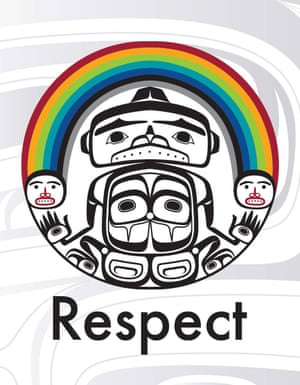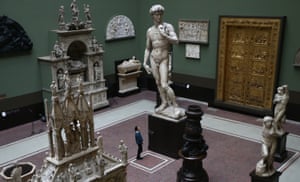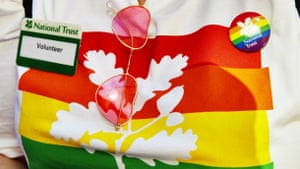(from today’s Guardian)
‘Let’s let them know we’re all here,” says Dan Vo, addressing a crowd of at least 100 in a space just off the domed entrance hall of London’s Victoria and Albert Museum. It’s the hottest day of the year so far, and the people fanning themselves with gallery maps have come to join the monthly LGBTQ tour, which Vo, a volunteer, helped set up four years ago. “On the count of three,” he bellows, “we’re just going to shout ‘queer’ – celebrating Stonewall, remembering how hard we fought to be here. One, two, three…” The word echoes off the barrel vaults of the sculpture hall and subsides as we head off in different directions – the tour is so popular that the group has to be split into at least six parties. Visitors are shown 10 or so objects throughout the museum, from a dress designed by Jean Cocteau to a sandstone sculpture of half-female, half-male deity Ardhanarishvara. The guides, who select the objects, are also volunteers, although the tours have been endorsed from on high: “Tristram [Hunt, the museum’s director] does write us very supportive letters,” Vo says. At the end, everyone goes for a drink.

Rainbow by Canadian First Nation artist Corey Bulpitt. Photograph: Corey Bulpitt/NativeNorthwest.com
A darkly jumbled 19th-century anthropological museum, the Pitt Rivers is an unlikely setting for cutting-edge identity politics. But its openness to queer perspectives is part of a wider ethos of interrogation, borne out by the fact that even members of staff describe the collection, gathered magpie-like from cultures around the world, as “incredibly problematic”. Curators are preoccupied by questions such as: How did this stuff get here? Who is it for? And what stories are being told about it? “I think this is a moment of huge change in museums and particularly in collections like [ours],” says head of education Andy McLellan. “When people came into the museum 20 years ago, they just went, ‘Isn’t the Pitt Rivers museum a quaint place! And it’s got these lovely handwritten labels and, oh, they’re a little bit iffy but it’s all about the atmosphere.’ And people are coming into the museum today and they’re saying, ‘You need to change this. You need to face up to these issues. We want to find out about them – we don’t want you hiding them.’”
Part of the response includes finding new ways to interpret the objects already on display, sifting through the vast stores to find hidden gems, and even “ethically collecting” new artefacts: the museum is in discussions about acquiring designs by Corey Bulpitt, a First Nations artist from Canada, whose work based on the traditional Haida motif of the rainbow has been adopted by LGBTQ activists. During a short tour of Pitt Rivers’ spectacular cast-iron central court, research assistant Mara Gold picks out a cabinet containing knickers made from reindeer skin, brought back from a research trip to Siberia in 1915 by the Polish cultural anthropologist Maria Czaplicka. Her work focused on shamanistic societies and, according to Gold, she was the first scholar to differentiate between cross-dressing and being transgender, both of which she identified in different Siberian groups.
The Pitt Rivers is working closely with both “originating communities” and local LGBTQ people to overhaul its collection in a process that will take up to two years. Back at the V&A, the criteria for deciding what features in the tours are more straightforward. “We have a rule of three for choosing things,” says Vo. “Either the creator is queer, or it could be the object itself depicts a queer subject. The third and most important one is that it’s something the community may have taken on board as part of their story.” The plaster reproduction of Michelangelo’s David in the museum’s cast room satisfies all of these requirements, by virtue of the homoerotic friendship between biblical figures David and Jonathan, Michelangelo’s reputed homosexuality, and the fact that the statue was used as a discreet come-on by travellers returning from the grand tour. “If you brought back a statue of David and had it on your shelf, it was usually an invitation, a hint for others to approach you and say, I think there might be things we can talk about.”

Signal … a five-metre-high cast of Michelangelo’s David in the V&A’s Cast Court. Photograph: Carl Court/Getty Images
Coded messages appear elsewhere in the museum, albeit in a different form. “I’m thinking of William Mulready and John Linnell,” Vo says, referring to 19th-century painters said to have been lovers. “It’s interesting that their paintings were placed side by side in the museum. Curators in the past left little signs like this for us to pick up.” And then there’s what Vo calls “historical gaydar”. “You can look at an object and think there’s something about this that I connect with. And more often than not it turns out that there is something [LGBTQ] there. There is definitely a quality that sort of vibrates across history to reach out and touch you.”
Harmless as they may seem – you don’t have to go on any of the tours, and the Pitt Rivers changes will affect only a fraction of its half-a-million items – efforts at queering haven’t always met with acclaim. The National Trust’s 2017 Prejudice and Pride programme, which aimed to show “how the often secretive lives of members of the LGBTQ community have helped shape the places we care for”, was labelled a “gay campaign” by the Telegraph and said to have provoked an (ultimately illusory) “membership crisis”. The Pitt Rivers is bracing for a similar reaction.

Backlash … the National Trust faced criticism over its attempt at LGBTQ recognition. Photograph: Arnhel de Serra/National Trust Images
“There is going to be backlash, for sure, but I welcome it,” says Hannah Bruce, the Beyond the Binary activities officer. Does she worry that some visitors will be alienated by all the focus on LGBTQ issues? “You mean people suddenly experiencing a feeling where they’re like, ‘Oh, I’ve never been excluded in my life before’? It kind of has to happen,” she says. “Some people are used to being represented. And there are these other communities that have had zero representation.”
People from those communities seem to be pretty happy about finally seeing themselves in the picture. James Daykin, 44, travelled from Banbury to attend the Pitt Rivers tour. “I think it’s fantastic. It’s the start of something.” Daykin points out that the queering of museums doesn’t serve the needs of just LGBTQ people. It’s for everyone, to show that “We’ve always been a part of society. We’ve always been contributors to society. We didn’t just appear 50 years ago. And we didn’t just appear 50 years ago with the intention to wreak havoc on the world, you know?”
By the end of the tour at the V&A, a mother and daughter from Edinburgh named Zoe Agnew, 60, and Harriet Phillips, 21, are bubbling over with excitement. “When Harriet first came out to me, I wasn’t in a good place at that time, so I wasn’t very accepting of it.” But that has changed to the extent that, as Harriet points out, the V&A visit was entirely her mum’s idea. “I just want to educate myself,” Zoe says.
“Once you start seeing it, you see it everywhere. Sculptures, paintings … and you just go, how come I never noticed this before? It’s all there, but it’s all been stifled – it’s all been shut up. It’s so life-affirming. You know, she’s my daughter, I love her, I want her to be able to live in a world where people accept her for who she is.”
At this point, Harriet beaming beside her, Zoe grabs me for a spontaneous hug, wondering out loud: “I don’t know if you hug journalists!” I assure her it’s fine, before leaving them in the shop, buoyed up by their infectious enthusiasm. Whatever else it does, a queered museum can definitely put a spring in your step.
- Beyond the Binary is at the Pitt Rivers Museum, Oxford. Pitt Rivers was shortlisted for Art Fund museum of the year in 2019. The V&A’s LGBTQ tour is on the last Saturday of every month.
